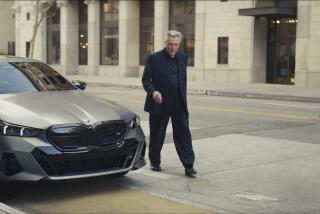Coke--Now It’s the Tinsel Town Thing : Marketing: CAA unveils a campaign that may revolutionize the ad industry.
- Share via
Coca-Cola has officially gone Hollywood--and Madison Avenue may never be the same.
A torrent of new Coke ads from Hollywood’s Creative Artists Agency, which wrestled the Coca-Cola Classic account away from New York’s advertising giant McCann-Erickson Worldwide, were unveiled Wednesday. Top ad executives say that, in addition to enlivening Coke’s image, they could dramatically change the way American advertising is created.
“This might be a turning point in the history of advertising,” said Rance Crain, editor in chief of the trade magazine Advertising Age.
The Coke ads shown Wednesday evoke everything from the staccato rhythms of MTV to the wistfulness of Steven Spielberg films. They are part of a new campaign theme with the motto “Always Coca-Cola,” which replaces the “You can’t beat the real thing” that Coke introduced in 1989. CAA’s integrated campaign also extends to radio and print, and includes an urban, contemporary theme song by a group called The Truth.
The ads were originally scheduled to premiere during ABC’s Academy Awards telecast March 29, but Coke executives are so high on the unconventional ads that they’ve bumped up the timetable and will begin airing the spots Sunday during the CBS miniseries “Queen.”
“Coca-Cola must be reinterpreted for each new generation,” said Donald R. Keough, president and chief operating officer of the company, at a hastily called New York news conference at the Museum of Television and Radio. Keough has not appeared at a Coca-Cola ad news conference in nearly a decade.
Peter S. Sealey, senior vice president and director of global marketing for Coca-Cola, said the company turned to CAA because “there’s a new media reality in the world today.”
“People don’t have to watch commercials anymore,” Sealey said. “We need to make them want to watch our advertising.”
McCann-Erickson, which has been Coke’s main agency since 1956, came up with the “Always Coke” theme, but CAA is responsible for 24 of the 26 new spots. One top ad executive estimated that Coke’s overall production costs for the spots exceed $10 million.
Executives from both CAA, headed by Michael S. Ovitz, and McCann-Erickson declined to comment on the new campaign, but Sealey credited CAA with bringing “a whole new perspective” to Coke.
Despite CAA’s sexy list of Hollywood clients, from Kevin Costner to Madonna, no CAA stars are featured in the ads, which were largely the brainchild of CAA executives Shelly Hochron and Len Fink. And while big-name Hollywood directors such as Rob Reiner and Richard Donner made spots, the bulk of the ads were filmed by conventional commercial directors.
“We didn’t have to pay much of a talent fee,” Keough said. “The star of these commercials is Coke.”
Among the crowd pleasers at the news screening were “Polar Bears,” in which a Spielberg-esque supernatural force provides Cokes to a pack of cuddly-looking animals from on high, and “The Glass Blower,” an erotic vignette in which a handsome man crafts a Coke bottle while a pretty woman ogles him.
Many of the ads have little or no dialogue, and Coke expects to save millions of dollars in production costs by broadcasting the same ads in the United States that it airs in Europe and South America.
The campaign, if successful, could lead other advertisers to turn away from traditional ad agencies in favor of Hollywood companies that some believe are better attuned to popular culture. And the evolution may not stop there.
Everything from corporate image consultants to production companies could play larger roles in future product advertising.
“In an image-intense business, smart marketers don’t care where creative ideas come from,” said Clive Chajet, chairman of the New York corporate identity firm Lippincott & Margulies. “No single type of organization has a monopoly on creative imagery.”
This new campaign may catch archrival Pepsi-Cola somewhat off guard. Although Pepsi unveiled new ads aimed at a younger audience during the Super Bowl, the company’s marketing efforts are now mostly concentrated on positioning its new clear cola, Crystal Pepsi.
At stake for both Coke and Pepsi is market share in America’s static soft drink industry. Some “natural” drinks, such as Snapple, and sports drinks, such as Gatorade, have lured consumers away from the soft drink makers. Soft drink sales growth slowed to 1.6% in 1992, compared to 2.8% just two years ago, according to Beverage Industry Digest. In 1992, Coca-Cola saw no increase in market share, and Pepsi-Cola saw a 0.4% decline compared to 1991.
Horovitz reported from Los Angeles and Zonana reported from New York.
More to Read
The biggest entertainment stories
Get our big stories about Hollywood, film, television, music, arts, culture and more right in your inbox as soon as they publish.
You may occasionally receive promotional content from the Los Angeles Times.










